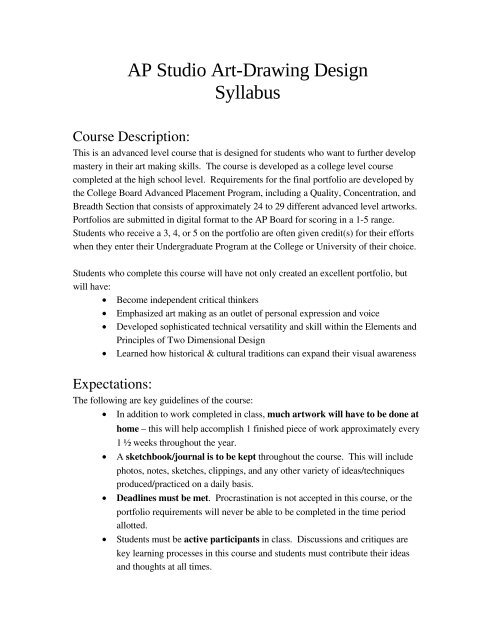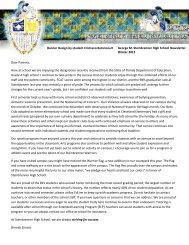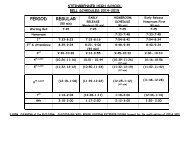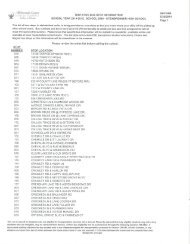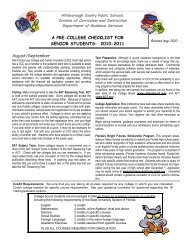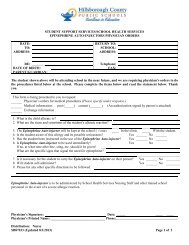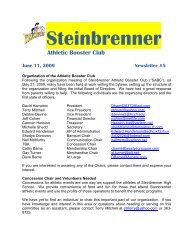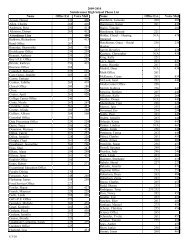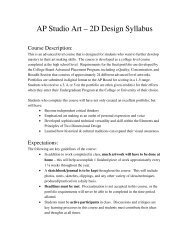AP Studio Art-Drawing Design Syllabus - Steinbrenner High School
AP Studio Art-Drawing Design Syllabus - Steinbrenner High School
AP Studio Art-Drawing Design Syllabus - Steinbrenner High School
You also want an ePaper? Increase the reach of your titles
YUMPU automatically turns print PDFs into web optimized ePapers that Google loves.
<strong>AP</strong> <strong>Studio</strong> <strong>Art</strong>-<strong>Drawing</strong> <strong>Design</strong><br />
<strong>Syllabus</strong><br />
Course Description:<br />
This is an advanced level course that is designed for students who want to further develop<br />
mastery in their art making skills. The course is developed as a college level course<br />
completed at the high school level. Requirements for the final portfolio are developed by<br />
the College Board Advanced Placement Program, including a Quality, Concentration, and<br />
Breadth Section that consists of approximately 24 to 29 different advanced level artworks.<br />
Portfolios are submitted in digital format to the <strong>AP</strong> Board for scoring in a 15 range.<br />
Students who receive a 3, 4, or 5 on the portfolio are often given credit(s) for their efforts<br />
when they enter their Undergraduate Program at the College or University of their choice.<br />
Students who complete this course will have not only created an excellent portfolio, but<br />
will have:<br />
• Become independent critical thinkers<br />
• Emphasized art making as an outlet of personal expression and voice<br />
• Developed sophisticated technical versatility and skill within the Elements and<br />
Principles of Two Dimensional <strong>Design</strong><br />
• Learned how historical & cultural traditions can expand their visual awareness<br />
Expectations:<br />
The following are key guidelines of the course:<br />
• In addition to work completed in class, much artwork will have to be done at<br />
home – this will help accomplish 1 finished piece of work approximately every<br />
1 ½ weeks throughout the year.<br />
• A sketchbook/journal is to be kept throughout the course. This will include<br />
photos, notes, sketches, clippings, and any other variety of ideas/techniques<br />
produced/practiced on a daily basis.<br />
• Deadlines must be met. Procrastination is not accepted in this course, or the<br />
portfolio requirements will never be able to be completed in the time period<br />
allotted.<br />
• Students must be active participants in class. Discussions and critiques are<br />
key learning processes in this course and students must contribute their ideas<br />
and thoughts at all times.
• Students must be prepared for class. Students must arrive to class on time<br />
with their materials, and use the class time to its fullest extent.<br />
• Respect is expected at all times. This includes respect for personal artwork,<br />
respect for other people’s artwork, respect for the classroom and materials, and<br />
most of all respect for people’s ideas, opinions, and feelings voiced in<br />
discussion.<br />
• Students must also study classic and contemporary artists and trends during the<br />
duration of the course. Students are expected to visit galleries and local art<br />
museums on their own 23 times during the year.<br />
• All artwork must be original! No published work can be used as a basis for<br />
personal artwork unless significant alteration to the image is completed. All<br />
imagery must be developed according to personal voice and any duplication of<br />
imagery from any source is not accepted.<br />
Summer Work:<br />
Students are to complete 3 works over the summer that will be included in the Breadth<br />
section of the <strong>AP</strong> <strong>Drawing</strong> <strong>Design</strong> Portfolio. The 3 finished pieces will be due on the first<br />
day of school, and will be critiqued during Week 1. 2D Research must be one of the works<br />
completed.<br />
While completing the summer work, students should:<br />
• Keep in mind the Principles of Three Dimensional <strong>Design</strong> – even though this is<br />
summer work it should still be technically developed as much as advanced inclass<br />
works would be.<br />
• Remember to get feedback about works in progress and about finished works.<br />
Some might ask parents or relatives to critique their works, some might ask<br />
friends, or digital images of the work can be emailed to the instructor with<br />
questions or for suggestions at any time.<br />
• 2D Research: Students will research artists who create different types of twodimensional<br />
artwork. Evidence of indepth research (photos, articles, personal<br />
history, student thoughts, etc.) should be available in the student’s sketchbook<br />
for at least 5 different artists throughout history.<br />
A few examples of artists who could be studied are:<br />
Claude Monet<br />
Vincent van Gogh
M.C. Escher<br />
Edgar Degas<br />
Paul Cezanne<br />
Jean AugusteDominique Ingres<br />
Frida Kahlo<br />
Edward Hopper<br />
Albrecht Durer<br />
Jean Baptiste Camille Corot<br />
Leonardo da Vinci<br />
Katsusika Hokusai<br />
William Blake<br />
Henri Matisse<br />
Possible Breadth projects:<br />
Creative Space with Aerial Perspective<br />
Observational <strong>Drawing</strong><br />
Expressive Hands<br />
Selfportraits (Abstract, Surreal, Monochromatic)<br />
Mixed Media <strong>Drawing</strong><br />
Nature<br />
Abstraction of object<br />
Surreal drawing in color<br />
Dreams and Nightmares<br />
Human Form<br />
Course Schedule:<br />
The <strong>AP</strong> <strong>Studio</strong> <strong>Art</strong> class will meet each school day for a 55 minute period. Students must<br />
enroll in all quarters of <strong>AP</strong> <strong>Studio</strong> <strong>Art</strong>, as the full year will be needed to complete the<br />
portfolio requirements. At the end of the year 1 ½ credits will be given to those who<br />
complete all required components of the course. The spreadsheet timeline for the year with<br />
all assignments is located at the end of this syllabus.<br />
During the first week of the course, students will be reintroduced to this syllabus and<br />
introduced to the <strong>AP</strong> <strong>Drawing</strong> <strong>Design</strong> Portfolio requirements in depth as explained in the<br />
<strong>AP</strong> <strong>Studio</strong> <strong>Art</strong> website. Extensive examples will be shown of works from the different<br />
sections of the portfolio, including those created by past <strong>AP</strong> <strong>Art</strong> students from the websites,<br />
as well as those given on the College Board “Slide Show & Commentary” CD, and<br />
website. Many discussions will be held, including an indepth conversation about
plagiarism and appropriate idea sources. Student summer work will be critiqued at this<br />
time, and a sharing session will be held about the information learned through the summer<br />
work about different <strong>Drawing</strong> artists. Students can use this information throughout the<br />
year to help develop their own styles and ideas within two dimensional drawing designs.<br />
Breadth (weeks 112)<br />
Within the Breadth Section of the portfolio twelve digital images will be needed of 12<br />
different works (1 views of each work). The Breadth Section is designed to demonstrate a<br />
variety of concepts, media, and approaches while emphasizing the elements and principles<br />
of drawing design such as balance, emphasis, contrast, figure/ground relationship,<br />
proportion, repetition, unity/variety, color, value, texture and rhythm.<br />
Breadth pieces will be completed first in the <strong>AP</strong> process. Students are encouraged to feed<br />
off one another – discussion and informal critiques are expected almost daily in order to<br />
enhance final products. Formal classroom critiques and/or written personal critiques will<br />
be completed after each piece is completed. It is also expected that students think about<br />
comments and suggestions previously given to them by the teacher or peers when creating<br />
each new work. Students should think about the portfolio process as a building block<br />
process – each skill, technique, and idea learned needs to be retained in order to move<br />
ahead. Unique and individual responses are expected for each assignment.<br />
Each year the progression of the Breadth assignments should change depending on the<br />
strengths and interests of the students enrolled in the course.<br />
Possibilities of Breadth assignments include:<br />
• Monochromatic Painting: Students will design and create a monochromatic<br />
painting. The design must have a theme as well as repetition of subject or object<br />
matter including the hue and tints and shades of that hue.<br />
• Perspective <strong>Drawing</strong>: The student will use varies spatial systems to design an<br />
image with the illusion of threedimensional forms including aerial views (multiple<br />
views). See M.C. Escher<br />
• Still Life Collage: The student will sketch 5 or more objects, scan, and alter the<br />
image. They will manipulate the stilllife collage by adding different color,<br />
textures, and contrast to produce a center of interest.<br />
• Golden Mean <strong>Drawing</strong>: The student will use the Divine Proportion and the golden<br />
rectangle to produce the ideal human form after studying Vitruvius, Leonardo da<br />
Vinci, and other Renaissance artists.<br />
• Portraits Mixed Media: The student will do gesture drawings of the skull of class<br />
mates, facial featuresall angles, and facial expressions in their sketch books. The
final images must contain texture, hand or hands, shadows, symbols of personal<br />
interest, culture or heritage. Student must have references to Frida Kahlo and her<br />
work.<br />
• Pattern Collage: The student will use fabric and paper patters to create a collage<br />
that shows different aspects of the dame event in one image. Journal entry of<br />
readings about Persian miniature paintings Abd Alla Musawwir The Meeting of the<br />
Theologians c. 154050 watercolor and Faith Ringgold quilts.<br />
• Surrealism <strong>Drawing</strong>: The student will design a painting exploring the dreams,<br />
fantasy, and subconscious thoughts of the mind. A trip to the Dali museum with<br />
your sketch books, must complete several (no less then 15) sketches of the work of<br />
Dali and your comments on his work. As well as readings before your museum<br />
visit.<br />
• Photo Collage: The student will use their own images (drawing, photography, &<br />
painting) to cut out shapes to create a composition in the manner of Romare<br />
Bearden.<br />
• Environments: The student will create a cityscape with the interior views of their<br />
favorite room in their home. The student will study Stuart Davis’s Still Scape and<br />
draw out the image and explain how he did both interior and exterior in one<br />
painting.<br />
• Landscape: The student will use oil pastels and images from the real world to<br />
convey a visual puzzle of space. The artist to write about here is Rene Magritte and<br />
the image The Blank Signature.<br />
• Understructure Painting: The student will develop an understructure of textures<br />
on their surface before painting their subject of choice. Student will research and<br />
review works of artists that use more than one material or approach in creating their<br />
work.<br />
• Close Up: The student will get very close to an object and create a drawing that<br />
verges on abstraction.<br />
• Negative & Positive Space: The student will so a drawing using the negative space<br />
of an object. They will cut out the positive space and re draw the object using the<br />
negative cut out.<br />
• Ink or Etching: The student will do an abstract portrait of a family member that<br />
has contributed to the student’s life in a positive form.<br />
• Charcoal, Conte’ or White Line <strong>Drawing</strong>: The student will do a drawing of a<br />
human in an environment of their choice.<br />
The Breadth section of the portfolio will be completed Thanksgiving break, documenting<br />
will be done after the break on week 12. If students are not happy with any of the specific<br />
pieces they created this year for the Breadth section, they do have the option of removing
those pieces and incorporating other successful pieces that they created in other art classes<br />
during previous years or redoing the work over break.<br />
Concentration (week 1330)<br />
The Concentration section of the <strong>AP</strong> portfolio consists of twelve digital images of artwork<br />
that can include details (ex. 11 different works with a close up detail digital of 1 work to<br />
show extreme detail or texture). The concentration section is designed to demonstrate an<br />
indepth exploration<br />
of one theme or idea. The theme should be of interest to the student in order to ensure<br />
excitement, dedication, and critical inquiry throughout the whole creation process for the<br />
large body of works.<br />
Though students should have been thinking about their Concentration theme throughout<br />
the first 12 weeks of class the 13 week through the 27 week will be dedicated to the<br />
development of a concrete idea for each <strong>AP</strong> student’s Concentration. The development is<br />
an ongoing process that uses informed decision making and critical thinking skills to refine<br />
their ideas. During this time students will consider these questions:<br />
• What are your interests/hobbies<br />
• What affects your life on a daily basis<br />
• What qualities make you love something<br />
• Do you see a theme that has developed in any of your personal artwork<br />
• What might you consider your obsession<br />
After establishing this list of answers, students will research the topics in depth and narrow<br />
down their ideas to a select few.<br />
After narrowing down their ideas, students will then turn to their artistic brain to decide the<br />
final idea. The remainder of the two weeks will be dedicated to sketching and designing<br />
ideas that might lead to pieces in the topic’s concentration. If one idea isn’t leading to<br />
diverse compositions and pieces of work, then students should move on to their next idea.<br />
Students will really push their creativity and develop many different sketches for one idea<br />
during this time period – when finding the final topic a student might have up to 100<br />
sketches for artworks. It is at this time the students can choose the direction they want to<br />
go within the idea and narrow down their sketches. They are now ready to start using the<br />
art materials and begin the concentration.<br />
A few examples of previous viewed or used 2D <strong>Design</strong> Concentrations are:<br />
• Making a drawing of a person or people from an unusual perspective such as above<br />
or below.<br />
• <strong>Drawing</strong> the head and shoulders (bust view) portrait using a variation of line.
• Plant drawing using dark background and light foreground.<br />
• Squares of paper, diagonal lines, and breaking up the space to create a Cubistic<br />
image.<br />
• Using an environment where the subject is closed up or confined in a small apace.<br />
• Architecture exterior drawing.<br />
• Architecture interior drawing.<br />
• Poems or song lyrics used in an image.<br />
• Color portrait using digital images and color harmony.<br />
• Tree drawings based on several artists rendering of trees.<br />
• Use foreshortening in a photograph and then collage other images to produce an<br />
abstract image.<br />
• Do a drapery drawing of the shadows and highlights seen on the cloth.<br />
• Boot or shoe drawing where the shoe/boot takes on the characteristics of the foot<br />
wear.<br />
As shown on the course timeline, the Concentration body of work will be created<br />
throughout week13 through weeks 27. Though each student will be working on individual<br />
themes and pieces using a variety of media, the class will continue to converse about and<br />
critique each piece. Formal and informal classroom critiques will be held, as well as<br />
written self critiques. Students will especially develop conversation about the diversity of<br />
their Concentration – though each individual piece revolves around the central theme, it<br />
still must be different and must not be too similar to any other piece in the body of works.<br />
This will prove to be the most difficult task of the course for most students.<br />
Quality (weeks 3136)<br />
The Quality section of the portfolio consists of 5 pieces of work that will be selected to<br />
show the <strong>AP</strong> <strong>Studio</strong> <strong>Art</strong> Readers in digital form (2 views of each piece) as examples of<br />
excellence and skill in all aspects of two dimensional drawing design principles. These 5<br />
pieces can be pulled from the Concentration and/or Breadth Sections of the portfolio, and<br />
do not necessarily even have to be new pieces.<br />
Beginning in Week 5, all students will begin rigorous critiques of both bodies of their<br />
work. This is the beginning step in deciding which pieces truly are the best and should be<br />
considered for the Quality Section of the portfolio. This process also allows students to<br />
pick out pieces that they might want to work on/tweak more before documentation of the<br />
work are completed.<br />
Each piece will be looked at and scored (with a 1=poor to 5=excellent scale) on the<br />
following criteria by the student as well as by the instructor:
• Material use/technique<br />
• Creativity/Imagination<br />
• Evidence of the Elements & Principles of <strong>Design</strong><br />
• Evidence of critical thinking & development of ideas<br />
• Composition<br />
• Personal Style/Voice<br />
Any piece that consistently scores in the 4 or 5 range will be considered as part of the<br />
Quality section. If more than 5 works are chosen in this range, then more critiques will be<br />
completed involving the whole class in order to choose a final set of 5.<br />
Digital documentation of work:<br />
Digital documentation will be taken at the high school using appropriate lighting and<br />
technology. This will happen during different weeks of the year: Breadth slides will be<br />
taken in the month of November and Concentration slides will be taken in the month of<br />
April. This is done at two separate times so sculptures don’t have the time to get broken<br />
before they can be photographed. When the images have been taken, students will<br />
appropriately label and arrange each image according to section (Concentration & Breadth)<br />
as well as label media and size of each original piece. Images will be printed and put in<br />
journals for all three sections. The Quality section will be documented labeled<br />
appropriately in the spring as well. The journal is their documentation of their process.<br />
Grades:<br />
Students will be graded each 9 week period based on the following criteria:<br />
<strong>Art</strong>work completedeach finished piece will receive a grade based on idea content,<br />
technique, effort, demonstrated use of media, composition and personal style and voice.<br />
<strong>Art</strong>work Completed 60%<br />
Sketchbook 15%<br />
Critique 15% .<br />
Participation/Attitude 10%<br />
Total 100%<br />
Note: Any student who does not complete all requirements of the <strong>AP</strong> <strong>Studio</strong> <strong>Art</strong> <strong>Drawing</strong><br />
<strong>Design</strong> portfolio (whether they send their portfolio to the College Board for scoring or not)<br />
will not receive credit for the course regardless of GPA for the year.<br />
Weekly Assignments:<br />
• Week 1 Introduction (Breadth 13 Summer work)
• Week 2 Breadth 4 & 5<br />
• Week 3 Work 4 & 5 continues: critique, sharing, discussion<br />
• Week 4 Breadth 6 & 7<br />
• Week 5 Work 6 & 7 continues: critique, sharing, discussion<br />
• Week 6 Breadth 8 & 9<br />
• Week 7 Work 8 & 9 continues: critique, sharing, discussion<br />
• Week 8 Breadth 10 & 11<br />
• Week 9 Work 10 & 11 continues: critique, sharing, discussion<br />
• Week 10 Breadth 12<br />
• Week 11 Work 12 continues: critique, sharing, discussion<br />
• Thanksgiving Option of redoing any Breadth work<br />
• Week 12 Documentation of Breadth<br />
• Week 13 Concentration: discussion & planning<br />
• Week 14 Concentration 1<br />
• Week 15 Work 1 continues: critique, sharing, discussion<br />
• Christmas Concentration 2 & 3 (critique, sharing, discussion<br />
after break)<br />
• Week 16 Concentration 4<br />
• Week 17 Work 4 continues: critique, sharing, discussion<br />
• Week 18 Concentration 5<br />
• Week 19 Work 5 continues: critique, sharing, discussion<br />
• Week 20 Concentration 6<br />
• Week 21 Work 6 continues: critique, sharing, discussion<br />
• Week 22 Concentration 7<br />
• Week 23 Work 7 continues: critique, sharing, discussion<br />
• Week 24 Concentration 8<br />
• Week 25 Work 8 continues: critique, sharing, discussion<br />
• Week 26 Concentration 9<br />
• Week 27 Work 9 continues: critique, sharing, discussion<br />
• Week 28 Concentration 10<br />
• Week 29 Work 10 continues: critique, sharing, discussion<br />
• Week 30 Concentration 11 & 12<br />
• April Vacation Finish Concentration (critique, sharing, discussion<br />
after break)<br />
• Week 31 Quality Discussion & planning<br />
• Week 32 Quality work touch up & documentation<br />
• Week 33 Exam Review
• Week 34 <strong>AP</strong> Exam Week<br />
• Week 35 Written artist statement about their portfolios and the <strong>AP</strong> process<br />
• Week 36 Graduation


